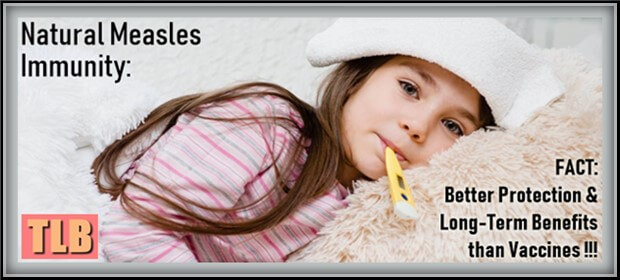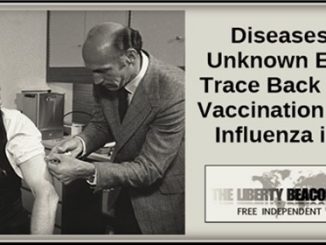
Natural Measles Immunity—Better Protection and More Long-Term Benefits than Vaccines
By TLB Project Contributor: World Mercury Project Team
Stories about vaccines in the popular press tend to be unabashedly one-sided, generally portraying vaccination as a universal (and essential) “good” with virtually no down side. This unscientific bias is particularly apparent in news reports about measles, which often are little more than hysterical diatribes against the unvaccinated.
Although public health authorities have made a case for measles eradication since the early 1980s, 50-plus years of mass measles vaccination and high levels of vaccine coverage have not managed to stop wild and vaccine-strain measles virus from circulating. Routine measles vaccination also has had some worrisome consequences. Perhaps the most significant of these is the shifting of measles risks to age groups formerly protected by natural immunity. Specifically, modern-day occurrences of measles have come to display a “bimodal” pattern in which “the two most affected populations are infants aged less than 1 year and adults older than 20 years”—the very population groups in whom measles complications can be the most clinically severe. As one group of researchers has stated, “The common knowledge indicating that measles [as well as mumps and rubella] are considered as benign diseases dates back to the pre-vaccine area and is not valid anymore.”
A little history (see video)
Before the introduction of measles vaccines in the 1960s, nearly all children contracted measles before adolescence, and parents and physicians accepted measles as a “more or less inevitable part of childhood.” In industrialized countries, measles morbidity and mortality already were low and declining, and many experts questioned whether a vaccine was even needed or would be used.
Measles outbreaks in the pre-vaccine era also exhibited “variable lethality”: in specific populations living in close quarters (such as military recruits and residents of crowded refugee camps), measles mortality could be high, but even so, “mortality rates differed more than 10-fold across camps/districts, even though conditions were similar.” For decades both prior to and following the introduction of measles vaccination, those working in public health understood that poor nutrition and compromised health status were key contributors to measles-related mortality, with measles deaths occurring primarily “in individuals below established height and weight norms.” A study of measles mortality in war-torn Bangladesh in the 1970s found that most of the children who died were born either in the two years preceding or during a major famine.
Moms who get measles vaccines instead of experiencing the actual illness have less immunity to offer their babies, resulting in a ‘susceptibility gap’…
Measles vaccination and infants
Before the initiation of mass vaccination programs for measles, mothers who had measles as children protected their infants through the transfer of maternal antibodies. However, naturally acquired immunity and vaccine-induced immunity are qualitatively different. Moms who get measles vaccines instead of experiencing the actual illness have less immunity to offer their babies, resulting in a “susceptibility gap” between early infancy and the first ostensibly protective measles-mumps-rubella (MMR) vaccine at 12 to 15 months of age.
A Luxembourg-based study published in 2000 confirmed the susceptibility gap in an interesting way. The researchers compared serum samples from European adolescents who had been vaccinated around 18 months of age to serum samples from Nigerian mothers who had not been vaccinated but had experienced natural measles infection at a young age. They then looked at the capacity of the antibodies detected in the serum to “neutralize” various wild-type measles virus strains. The researchers found that the sera from mothers with natural measles immunity substantially outperformed the sera from the vaccinated teens: only two of 20 strains of virus “resisted neutralization” in the Nigerian mothers’ group, but 10 of 20 viral strains resisted neutralization in the vaccination group. This complex analysis led the authors to posit greater measles vulnerability in infants born to vaccinated mothers.
…many vaccines may eventually become susceptible to vaccine-modified measles…and consequently complicate measles control strategies.
The Luxembourg researchers also noted that in the Nigerian setting, where widespread vaccination took hold far later than in Europe, the mothers in question had had “multiple contacts with endemic wild-type viruses” and that these repeat contacts had served an important booster function. One of the authors later conducted a study that examined this booster effect more closely. That study found that re-exposure to wild-type measles resulted in “a significantly prolonged antibody boost in comparison to [boosting through] revaccination.” Taking note of expanding vaccine coverage around the world and reduced circulation of wild-type measles virus, the researchers concluded in a third study that “many vaccines may eventually become susceptible to vaccine-modified measles…and consequently complicate measles control strategies.”
Bimodal distribution
With the disappearance of maternally endowed protection, what has happened to measles incidence in infants? A review of 53 European studies (2001–2011) focusing on the burden of measles in those “too young to be immunized” found that as many as 83% of measles cases in some studies and under 1% in other studies were in young infants.
At the same time, the predictions of an increased percentage of measles cases in older teens and adults have also come true. Reporting on a higher “death-to-case ratio” in the over-15 group in 1975 (not many years after widespread adoption of measles vaccination in the U.S.), a Centers for Disease Control and Prevention (CDC) researcher wrote that the higher ratio could be “indicative of a greater risk of complications from measles, exposing the unprotected adult to the potential of substantial morbidity.”
In recent measles outbreaks in Europe and the U.S., large proportions of cases are in individuals aged 15 or older:
- In the U.S., 57 of the 85 measles cases (67%) reported in 2016 were at least 15 years of age. U.S. researchers also have conservatively estimated that at least 9% of measles cases occur in vaccinated individuals.
- Among several thousand laboratory-confirmed cases of measles and an additional thousand “probable” or “possible” cases in Italy in 2017, 74% were in individuals at least 15 years of age, and 42% of those were hospitalized.
- Examining a smaller number of laboratory-confirmed measles cases in Sicily (N=223), researchers found that half of the cases were in adults age 19 or older, and clinical complications were more common in adults compared to children (45% versus 26%). Likewise, about 44% of measles cases in France from 2008 to 2011 (N=305) were in adults (with an average age in their mid-20s), and the adults were more than twice as likely to be hospitalized as infected children.
Time to reevaluate
Pre-vaccination, most residents of industrialized countries accepted measles as a normal and even trivial childhood experience. Many people, including clinicians, also understood the interaction between measles and nutrition, and, in particular, the links between vitamin A deficiency and measles: “Measles in a child is more likely to exacerbate any existing nutritional deficiency, and children who are already deficient in vitamin A are at much greater risk of dying from measles.” Instead of inching the age of initial measles vaccination down to ever-younger ages, as is increasingly being proposed, there could be greater value in supporting children’s nutrition and building overall health—through practical interventions that “improve[e]…existing dietaries through the inclusion of relatively inexpensive foods that are locally available and well within the reach of the poor.”
Ironically, while acute childhood infections such as measles protect against cancer, the rise of chronic childhood illnesses (disproportionately observed in vaccinated children) is linked to elevated cancer risks.
There are many other tradeoffs of measles vaccination that remain largely unexplored, including the important role of fever-inducing infectious childhood diseases in reducing subsequent cancer risks. Ironically, while acute childhood infections such as measles protect against cancer, the rise of chronic childhood illnesses (disproportionately observed in vaccinated children) is linked to elevated cancer risks. These tradeoffs—along with the dangerous loss of infant access to protective maternal antibodies and the higher rates of measles illness and complications in older teens and adults—suggest that measles vaccination deserves renewed scrutiny.
••••
TLB Note: Please Take the time to Sign up for breaking news and updates from Robert F. Kennedy, Jr. and the ‘Outstanding’ World Mercury Project. Your donation will help to support them in their phenomenal efforts.
••••
Read more great articles by World Mercury Project
••••
The above published article (Natural Measles Immunity—Better Protection and More Long-Term Benefits than Vaccines) originated on worldmercuryproject.org and is republished here by generous contribution, with attribution to author ‘World Mercury Project Team’ and worldmercuryproject.org
••••
The Liberty Beacon Project is now expanding at a near exponential rate, and for this we are grateful and excited! But we must also be practical. For 7 years we have not asked for any donations, and have built this project with our own funds as we grew. We are now experiencing ever increasing growing pains due to the large number of websites and projects we represent. So we have just installed donation buttons on our websites and ask that you consider this when you visit them. Nothing is too small. We thank you for all your support and your considerations … TLB
••••
Click on the image below to visit TLB Project on twitter …




